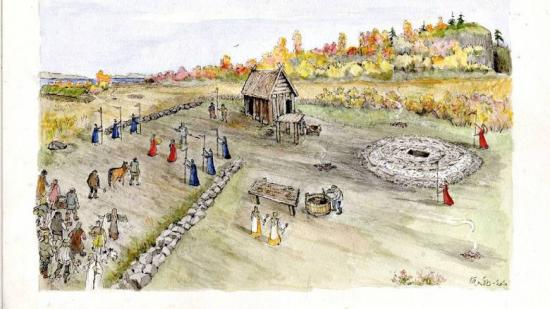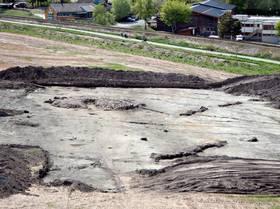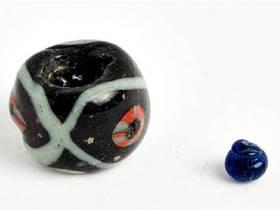Acharya S/D.M. Murdock
Source - http://www.freethoughtnation.com/contributing-writers/63-acharya-s/666-ancient-unparalleled-pre-christian-temple-discovered-in-norway.html

Artist's rendering of the original 'god temple,' with sacrifice altar, staff house in center and procession on road to left [Credit: Preben Rønne, Science Museum/NTNU]
A fascinating discovery is shedding light upon pre-Christian Scandinavian religion and early Christian inroads into Norway. In the Norwegian press, this highly important find is being called "unparalleled," "first of its kind" and "unique," said to have been "deliberately and carefully hidden" - from invading and destructive Christians.
Located at the site of Ranheim, about 10 kilometers north of the Norwegian city of Trondheim, the astonishing discovery was unearthed while excavating foundations for new houses and includes a "gudehovet" or "god temple." Occupied from the 6th or 5th century BCE until the 10th century AD/CE, the site shows signs of usage for animal sacrifice, a common practice among different peoples in antiquity, including the biblical Israelites. (E.g.,Num 7:17-88) Over 1,000 years ago, the site was dismantled and covered by a thick layer of peat, evidently to protect it from marauding Christian invaders. These native Norse religionists apparently then fled to other places, such as Iceland, where they could re-erect their altars and re-establish the old religion.
In "Unparalleled pagan sanctuary found," the Norwegian newspaper Aftenposten reports:
The pagan sanctuary survived because the last people who used it over 1,000 years ago did their utmost to hide the entire system with an unusually thick layer of soil....

The excavated temple [Credit: Preben Rønne, Science Museum/NTNU]
"The discovery is unique in a Norwegian context, the first ever made in our latitudes," says Preben Rønne of the Science Museum/University of Trondheim, who led the excavations.
Animal blood sacrifice
The god temple may have been built sometime around or after the year 400 AD, thus used for hundreds of years until the people emigrated to avoid Christianity's "straitjacket." It consisted of a stone-set "sacrificial altar" and also traces of a "pole building" that probably housed idols in the form of sticks with carved faces of Thor, Odin, Frey and Freya. Deceased relatives of high rank were also portrayed in this way and attended. Nearby, the archaeologists also uncovered a procession route.
Thanks to the soil, the god temple was very well preserved. The "altar" where one worshiped the gods and offered animal blood consisted of a circular stone setting around 15 meters in diameter and nearly a meter high. The pole building a few meters away was rectangular, with a floor plan of 5.3 x 4.5 meters, and raised with 12 poles, each having a solid stone foundation. The building may have been high and, from the findings, was very clearly not used as a dwelling. Among other reasons, it had no fireplace. Inside the "house" were found traces of four pillars that may be evidence of a high seat where the idols stood between ceremonies. The processional road west of the temple and headed straight towards the pole building was marked with two parallel rows of large stones, the longest sequence at least 25 feet long.
Strange burial mound
When archaeologists began excavation work last year, the site was thought at first to be a flat burial mound with a "master's grave" and one or more secondary graves.
"But as we dug, the mound appeared more and more strange," says Rønne.
"Approximately in the middle of the excavation, we had to admit that it was not a burial mound but a sacrificial altar, in the Norse sources called a 'horg.' It was made up of both round 'dome rocks' and stone slabs. During our work, we found two glass beads, and also some burned bones and traces of a wooden box that had been filled with red-brown sand/gravel and a cracked boiling stone. Among the bones, we found part of a skull and several human teeth. However, we found no 'gold old men,' small human figures of thin gold, which were often used in connection with sacrifices."
The latest dating of the god temple is between 895 and 990 AD. Precisely during this period Christianity was introduced by heavy-handed methods into Norway. This meant that many left the country to retain their original god-belief.
"Probably the people who used the temple were among those who chose to emigrate, either to Iceland or other North Atlantic islands," said Rønne. "Posts for pole building were in fact pulled up and removed. The whole 'altar' was carefully covered with earth and clay, precisely at the transition to Christian times. Therefore, the cult site was completely forgotten."

Glass beads which were found during the excavation on the top of the altar [Credit: Preben Rønne, Science Museum/NTNU]
Unique in Norway
Large pre-Christian cult sites in Scandinavia - often large settlements with a large central hall, frequently with a smaller attached building - have been found not in Norway, but, rather, in Central and Southern Sweden (Skåne), also in eastern Denmark.
"In the sacrificial altar, we found a fire pit that actually lay directly on the prehistoric plow layer. The charcoal from this grave is now dated to 500-400 BC. Thus, the place could have been regarded as sacred or at least had a special status long before the stone altar was built. In the prehistoric plow layer under the fire pit, we could clearly see the traces of plowing with an 'ard,' a plow precursor," said Rønne.